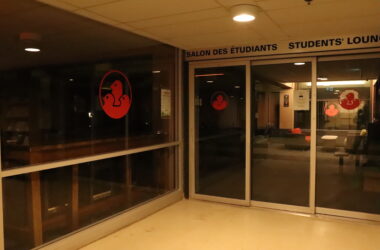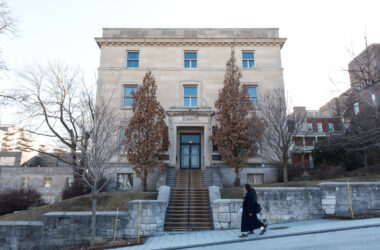Momentum is building to move the Hochelaga Rock to a more prominent location on campus. A symbol of Iroquoian and Canadian history, the rock currently sits on lower field in between the Roddick Gates and the Welcome Centre.
The Hochelaga Rock was installed in the 1950s by Parks Canada to commemorate the indigenous history of Montreal.
In 1860, construction workers found unusual relics at the corner of Metcalfe and Burnside, leading geologist and McGill principal Sir John William Dawson to suggest he had found relics from Hochelaga, the indigenous settlement where where Jacques Cartier landed in 1535.
After organizing a Kanata conference this fall where social work professor Michael Loft noted the general lack of awareness of the rock, U2 arts student and Kanata executive Jimmy Gutman sought to bring the rock to students’ attention.
Gutman brought a motion to move the rock to a more visible location to the Jan. 31 AUS General Assembly. The motion passed as a recommendation to the AUS Council. The following day, AUS VP Academic Yusra Khan brought the motion to AUS Council where it also passed-this time as a mandate.
SSMU President Maggie Knight explained that dean of students Jane Everett is currently engaged in consultation with members of the McGill community to determine a better, more visible location for the rock, as a result of discussions in one of McGill’s senate committees on a recommendation from the Aboriginal Affairs Work Group.
Paige Isaac, Interim Co-ordinator of the First Peoples’ House (FPH), said that the FPH is undergoing consultations during the summer in order to prepare for the rock’s move, which they hope will take place this fall.
“We … plan on co-aligning the moving of the rock with a celebration, most likely at our annual Pow Wow in September,” Isaac wrote in an email to the Tribune. “Our Elder, Alex Sonny Diabo, will be involved in the ceremony.”
The purpose of moving the rock is to increase awareness of Iroquoian history, and Isaac said she aims to have the rock included as part of the Welcome Centre’s tour of McGill’s downtown campus.
“The rock right now is not visible and we are not giving it the attention it deserves-not just the rock, but the acknowledgement of the traditional territory,” she wrote. “We hope to increase this knowledge and celebrate it.”








